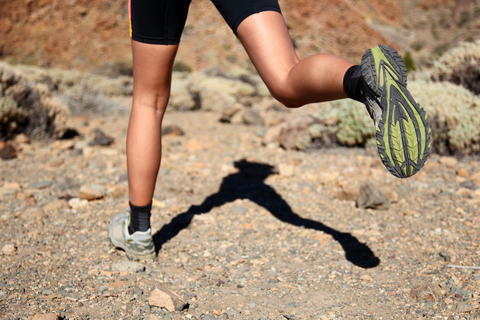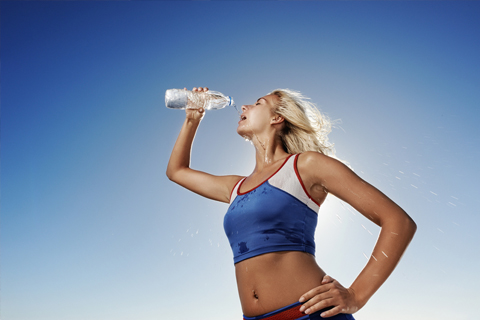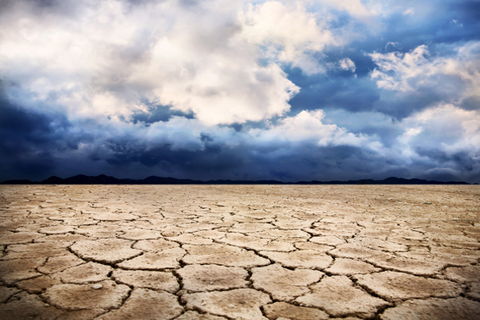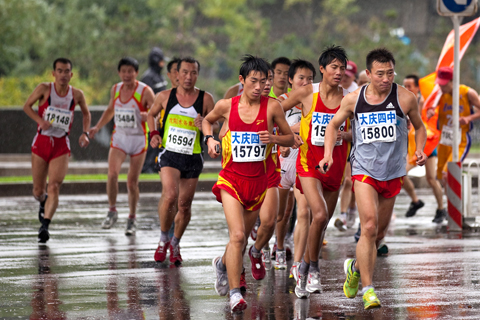Health Tips for Extreme Race Conditions
by Tim Allardyce
01 November 2011
Endurance sports, such as marathon running or bicycle racing, are physically, mentally and physiologically demanding on the body and psyche. Individuals participating in endurance sports must be certain to maintain temperature homeostasis, as well as, minimise strain and psychological stressors during prolonged exercise.
The hypothalamus in the brain controls the body’s temperature regulators. The body’s natural thermoregulatory system will work constantly to maintain a normal body temperature, 98.6 degrees Fahrenheit, during exercise. It’s important to equip yourself for extreme race conditions – especially when tackling a physical challenge in an environment that you’re not used to.
Extreme Heat…… Hyperthermia
Hyperthermia is basically the opposite of the well known condition hypothermia, and occurs when the body temperature becomes abnormally high. Over 70 percent of the body’s heat is transferred to the core during high endurance sports. The heat triggers the body to produce sweat which helps to balance the rise in heat. When body temperature rises faster than the body is able to dissipate the heat, the body starts to over-heat, and this is when you are most at risk of hyperthermia.
In extreme hot and dry conditions, the athlete must remain hydrated because 98 percent of the body’s heat is lost through evaporation. So if you don’t keep hydrated, you can’t sweat. If you can’t sweat, you can’t cool down, and that’s when the trouble starts.
Dehydration
Extreme dry and heat conditions disturb the balance of water to electrolytes in the blood and increase risk for dehydration. The symptoms of dehydration occur after 2 percent of the normal water volume has been lost. The racer may experience muscle fatigue, lower endurance levels, elevated body temperatures, rapid heart rates, dizziness, constipation, and a 30 percent performance decrease as a result of dehydration.
My advice is to drink an extra 8 to 16 ounces of fluid (1/4 litre to ½ litre) to avoid dehydration in extreme heat conditions. Dress lightly which will reduce the amount of heat conserved, and also wear white clothes which will help reflect some of the sun’s energy and heat.
Heat Stroke, Heat Exhaustion and Heat Cramps
Heat stroke typically occurs after prolonged exertion. The body’s thermoregulatory system cannot dissipate the heat faster than it is generated by the body’s core. The athlete may experience a heat stroke as an indicator of the problem. Heat stroke can occur in extreme hot and cold conditions.
Symptoms of heat exhaustion include dizziness, nausea, a rise in body temperature, vomiting, loss of coordination and headache. Exercising in extreme heat can also result in muscles cramps because of the imbalance of electrolytes in the blood. If either occurs, stop exercising, hydrate the body, cool the body with wet towels, elevate the legs, stay out of the sun and get a friend to contact the race doctor ASAP!
Extreme Humidity
This can be dangerous because the body is unable to sufficiently evaporate the sweat due water saturation in the surrounding air. The body perceives the temperature to be higher than it actually is, because the body cannot evaporate the sweat. Be careful with over-exercising in these humid conditions, rest and cool down while taking on extra water.
Extreme Wet Conditions
It is recommended to layer clothes when exercising in wet conditions. Avoid wearing excessive amounts of clothing or the athlete will experience decreased performance from the added weight. The layer closest to the body should be polypropylene, designed to draw the moisture away from the body. The second layer can consist of a breathable weather proofing layer, such as Gore-Tex or nylon, to protect from external elements.
Extreme Cold and Wind
Hypothermia occurs when the heat generated from the body’s core is not sufficient enough to counteract the cold air in the environment and the body’s temperature falls below normal. In extreme cold, metabolism (the ability for the body cells to function) and other body processes are difficult to maintain. Symptoms may include slurred speech, loss of coordination, extreme shivering, and fatigue.
It is important to wear layers, but not too many, and stay dry. Wear clothes made of polypropylene that draws sweat away from the body. Additionally, if you become wet, change immediately. Cold, wet conditions increase the likelihood of hypothermia. Forty percent of body heat is lost through the head and thirty percent through hands and feet. Protect the extremities by wearing a hat, mittens and extra socks that helps to keep the body temperature warm. In extreme cold, wear a scarf around the mouth to warm the air as it is inhaled… nobody wants frozen lungs (and I’m not joking!).
Extreme Altitudes
At high altitudes, oxygen levels are reduced. Oxygen is transported in the blood around the body to feed the muscles which helps produce energy. Reduced oxygen means reduced muscle energy and hence fatigue. Scientists believe that moderate training at high altitudes may play a role in enhancing the body’s respiratory and cardiovascular systems. Athletes are encouraged to return to sea level for high endurance training to alleviate strains on the body due to inadequate oxygen during prolonged aerobic exercise.
Water saturation at high altitudes is around 20 percent. Since there is less humidity, there is a greater chance for dehydration because the water evaporates more rapidly from the skin. In these conditions, the athlete has the impression that the body is cooler than it actually is.
Exercise at high altitudes burns more carbohydrates and less fats. At high altitudes, eat smaller and more frequent carbohydrate rich meals. Increase your intake of water by an extra ¼ – ½ litre per hour. Take frequent naps and consider investing in an altitude tent to lower pressure while sleeping at high altitudes.
Steep Gradients
Change your stride and alternate between walking and running. This will decrease strain on muscles that may result in injury. Sensible choice of route up and downhill is essential; tackle a gradient too steep and you could see yourself slipping over, or falling. Don’t risk a sprained ankle or torn ACL – take a sensible route. Also wearing good fitting shoes which support the ankle is essential on rough terrain.
Poor Road Conditions
This can affect the athlete if he or she encounters uneven terrain during exercise. Injuries may include sprains, uneven muscle development, and possibly even fractures. Pay close attention to the road surface to avoid injury. Also be aware of slippery paths in wet conditions, especially if there are a lot of leaves on the ground.
This article was written by Tim Allardyce, you can see all his articles here.









